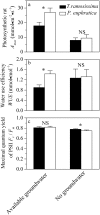Early direct competition does not determine the community structure in a desert riparian forest
- PMID: 29540784
- PMCID: PMC5852026
- DOI: 10.1038/s41598-018-22864-y
Early direct competition does not determine the community structure in a desert riparian forest
Abstract
In riparian zones along the Tarim River in northeastern China, the co-dominance by Populus euphratica and Tamarix ramosissima at the early succession stage shifts to P. euphratica dominance in the late stages. However, little is known about how this shift is mediated by the highly variable water conditions in riparian zones. Here we conducted a mesocosm experiment in which we measured the physiological and morphological traits of these two co-occuring species grown in mixtures under simulated favorable groundwater condition and no groundwater availability. Results indicated that T. ramosissima, in comparison to P. euphratica, had much lower WUE, less proportion of root biomass under favorable groundwater condition. Under no groundwater condition, T. ramosissima also showed higher maximal quantum yield of PSII which allowed it to accumulate higher aboveground and total biomass. Therefore, regardless of groundwater conditions, T. ramosissima exhibited superior competitive advantages against P. euphratica under direct competition condition, which demonstrates that the dominance shift was not resulted from the direct competition at seedling stage. Our findings further imply that a strategy of "sit and wait" in P. euphratica might favor its growth and survival when suffered flooding disturbances, thus allowing P. euphratica not being excluded through competition at early successional stage.
Conflict of interest statement
The authors declare no competing interests.
Figures






Similar articles
-
Physiological and morphological responses of Tamarix ramosissima and Populus euphratica to altered groundwater availability.Tree Physiol. 2013 Jan;33(1):57-68. doi: 10.1093/treephys/tps120. Epub 2012 Dec 13. Tree Physiol. 2013. PMID: 23243028
-
The effects of groundwater depth on water uptake of Populus euphratica and Tamarix ramosissima in the hyperarid region of Northwestern China.Environ Sci Pollut Res Int. 2016 Sep;23(17):17404-12. doi: 10.1007/s11356-016-6914-8. Epub 2016 May 26. Environ Sci Pollut Res Int. 2016. PMID: 27230143
-
[Seasonal variation of Tamarix ramosissima and Populus euphratica water potentials in southern fringe of Taklamakan Desert].Ying Yong Sheng Tai Xue Bao. 2005 Aug;16(8):1389-93. Ying Yong Sheng Tai Xue Bao. 2005. PMID: 16262046 Chinese.
-
Riparian plant community responses to increased flooding: a meta-analysis.Glob Chang Biol. 2015 Aug;21(8):2881-90. doi: 10.1111/gcb.12921. Epub 2015 Jun 8. Glob Chang Biol. 2015. PMID: 25752818 Review.
-
Phreatophytic vegetation and groundwater fluctuations: a review of current research and application of ecosystem response modeling with an emphasis on great basin vegetation.Environ Manage. 2005 Jun;35(6):726-40. doi: 10.1007/s00267-004-0194-7. Environ Manage. 2005. PMID: 15940400 Review.
Cited by
-
Responses of two dominant desert plant species to the changes in groundwater depth in hinterland natural oasis, Tarim Basin.Ecol Evol. 2021 Jun 16;11(14):9460-9471. doi: 10.1002/ece3.7766. eCollection 2021 Jul. Ecol Evol. 2021. PMID: 34306635 Free PMC article.
-
Impact of groundwater depth and soil salinity on riparian plant diversity and distribution in an arid area of China.Sci Rep. 2020 Apr 29;10(1):7272. doi: 10.1038/s41598-020-64045-w. Sci Rep. 2020. PMID: 32350302 Free PMC article.
-
Structural dynamics of Populus euphratica forests in different stages in the upper reaches of the Tarim River in China.Sci Rep. 2020 Feb 21;10(1):3196. doi: 10.1038/s41598-020-60139-7. Sci Rep. 2020. PMID: 32081960 Free PMC article.
References
-
- Descamps-Julien B, Gonzalez A. Stable coexistence in a fluctuating environment: an experimental demonstration. Ecology. 2005;86:2815–2824. doi: 10.1890/04-1700. - DOI
-
- Chesson PL, Warner RR. Environmental variability promotes coexistence in lottery competitive systems. Am. Nat. 1981;117:923–943. doi: 10.1086/283778. - DOI
-
- Chesson P. Multispecies competition in variable environments. Theor. Popul. Biol. 1994;45:227–276. doi: 10.1006/tpbi.1994.1013. - DOI
-
- Chesson P. Mechanisms of maintenance of species diversity. Annu. Rev. Ecol. Syst. 2000;31:343–66. doi: 10.1146/annurev.ecolsys.31.1.343. - DOI
Publication types
MeSH terms
LinkOut - more resources
Full Text Sources
Other Literature Sources

